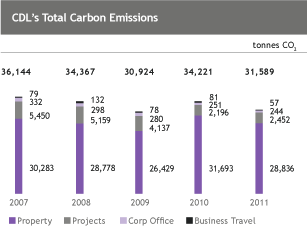

Building a green development is more than just incorporating eco-friendly features within a property. CDL takes concerted and sustained efforts that affect the entire supply and development chain. A holistic life-cycle approach — from design, construction, procurement, maintenance and user engagement, ensures business alignment with the Company’s environmental bottom line and creates positive impacts throughout the value chain.
CARBON EMISSIONS
Climate change continues to be an urgent global issue that requires international attention and action.Low-lying and densely populated, Singapore is at risk from the adverse impacts of climate change(1). Effects possibly include coastal land loss, flooding, water resource impacts, heat stress, public health implications from the resurgence of diseases and impact on island and marine biodiversity.
As an alternative-energy disadvantaged country which accounts for less than 0.2% of global greenhouse gases, Singapore’s key strategy to tackle carbon emissions is to improve energy efficiency in all sectors — transport, households, industry and buildings. Buildings contribute about 16% of Singapore’s national greenhouse gases emissions and CDL is committed to addressing climate change in our business operations and further reducing our carbon footprint.
In 2011, we have reduced CDL’s total carbon intensity emissions as measured in tonnes CO2/m2 by 7% from baseline year 2007. In other words, we produced less carbon per leased square metre of area. Since 2009, CDL voluntarily reduced our annual carbon emissions to “net zero”(2) for 11 Tampines Concourse, the first CarbonNeutral® development in Singapore and Asia Pacific, and our Corporate Office operations including our data centre.

| (1) | National Climate Change Secretariat — Singapore vulnerabilities to climate change (March 2008). |
| (2) | ‘‘Net zero’’ or carbon neutralise refers to achieving net zero carbon emissions by balancing a measured amount of carbon released with an equivalent amount offset. |
ENERGY
Singapore faces many energy resources constraints and has limited potential to adopt renewable energies, hence the national focus on energy efficiency.Buildings account for about one-third of national electricity consumption. CDL remains committed to improving our energy performance across all our business operations so that we can reduce electricity consumption and carbon emissions.
CDL has been harnessing renewable energy for our developments through the implementation of solar and Building Integrated Photovoltaic (BIPV) panels. In 2011, CDL buildings generated a total of 198,935 kWh of renewable energy.
CDL promotes the use of electricity directly from the power grid supply through a sub-station at the construction stage whenever possible. This significantly reduces the use of diesel generators sets. The use of electricity grid power supply generates lower emissions of greenhouse gases, sulfur oxides, nitrogen oxides and particulates to the environment as compared to using a generator.
By 2011, significant energy reduction of 22% has been achieved at CDL’s Corporate Office since 2006, mainly contributed by retrofitting with energy efficient lightings and equipments such as Nanoflex Reflectors, timers, motion sensors, LED lights, VAV Smart Cooling diffusers and central air-con system. All new purchases of office equipment are certified with the Energy Star Label.

CDL has introduced various energy conservation and efficiency improvements projects in our investment properties(3). For instance, King’s Centre will reap an estimated energy savings of 483,017 kWh per year by the chiller plant, replacement of less efficient lightings and adopting the use of solar panels in 2011. For some investment properties, sensors are installed to monitor carbon dioxide levels in offices, and carbon monoxide levels in the basement car park. Since 2007, the Company’s “1°C Up Programme” has become a standard BAU practice at CDL buildings, keeping indoor temperatures at 24°C on average.
| (1) | Energy conversion ratio: 1 kWh = 0.0036 gigajoules (GJ). |
| (2) | From November 2009, we have included the electricity and water data of three new buildings (City Square Mall, 11 Tampines Concourse and 7 & 9 Tampines Grande) in the reporting. |
| (3) | CDL's property segment refers to five industrial buildings and 11 commercial buildings as of 2011. |